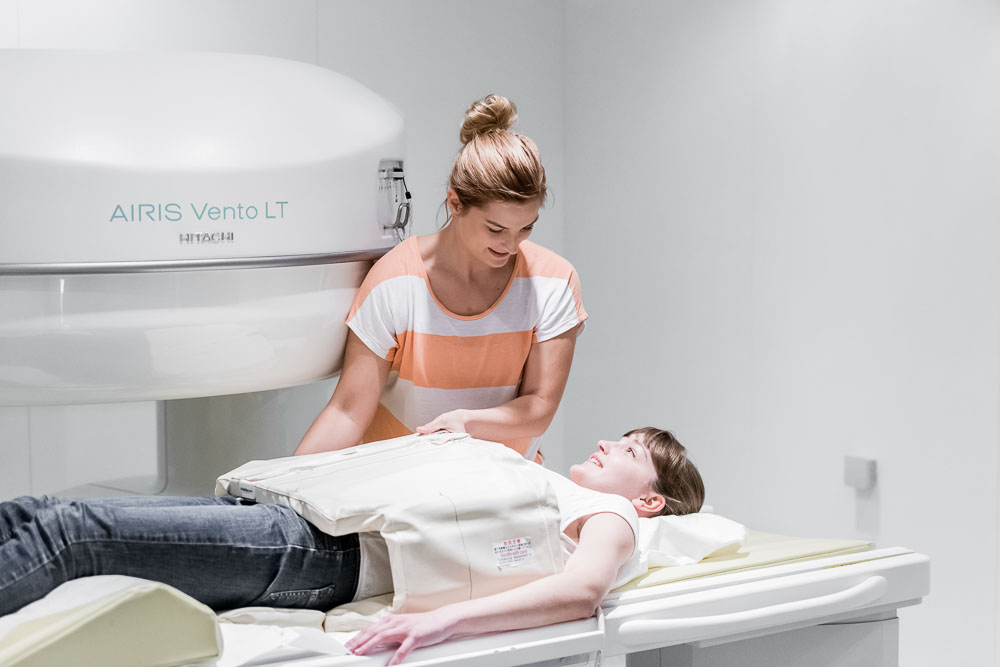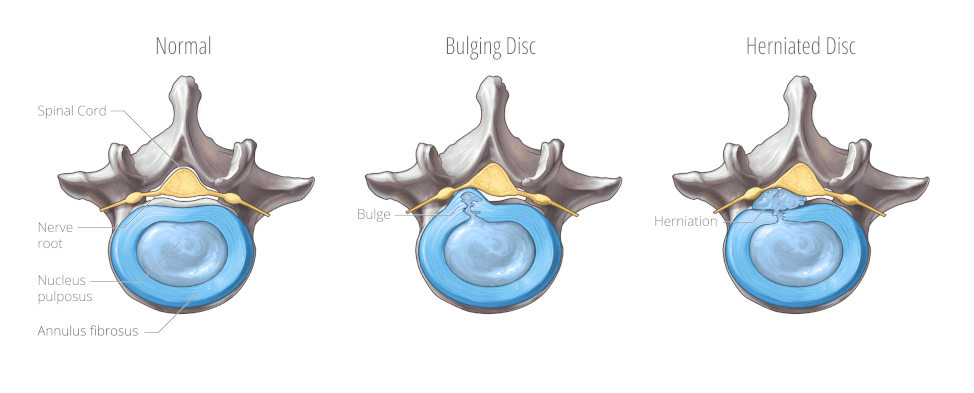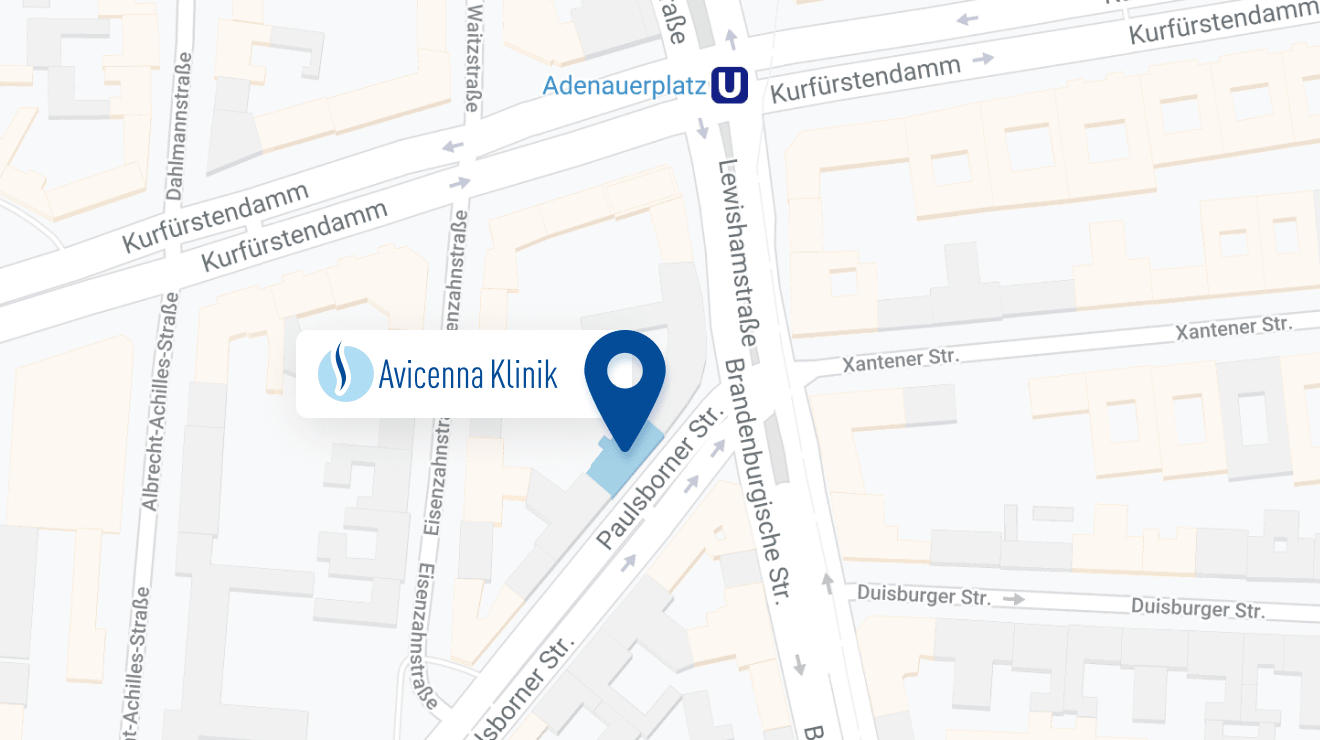What is a disc protrusion?
Bulging of the disc or disc protrusion is called in the medical jargon "protrusion of the intervertebral disc", this means that the disc protrudes towards the nerve canal. The protrusion could still be an “incomplete” hernia and can be considered as an early stage of a disc hernia. As we all know, the intervertebral discs connect 2 vertebral bodies of the spinal column. Humans have 23 intervertebral discs consisting of a fibrous ring (annulus fibrous) and a softcore (nucleus pulposus). The intervertebral discs mainly attenuate the pressure developed on the spine. In case of disc slippage (hernia), the gelatinous material of the nucleus comes out through a rupture of the fibrous ring in the spinal canal and presses directly on a nerve root, causing pain. Unlike this, in case of protrusion, there is no rupture but the nucleus material bulges in one direction and in turn shifts the ring of fiber and with this indirectly presses on the neural structures. In the worst case the fibrous ring is slightly torn. As a matter of fact, disc protrusions can occur anywhere in the spine. The most commonly affected are the lower sections of the lumbar spine, the thoracic and cervical area on the contrary are rarely affected.
The main causes of disc protrusion
As with all diseases, when we talk about the causes of disc protrusion we cannot refer to a single one because it is an interaction of several factors. Let's start with the protrusion accompanied by the degeneration of the intervertebral disc. Degeneration is a slow process that damages the intervertebral disc. In general, a protrusion of the intervertebral disc occurs because the intervertebral disc nucleus loses its elasticity due to a natural reduction of the water content. As a result, the fiber ring can no longer maintain its holding function; it evades the pressure of the gelatinous core and arches itself.
The structural weakening of the intervertebral disc significantly increases the risk of protrusion. No wonder, then, that most of the protrusions on the ground are caused by many years of previous damage. The main reasons are usually excessive strains. Lifting heavy objects, sudden and erratic movements during sport - often trigger a sudden protrusion. A protrusion of the intervertebral disc is therefore mainly present whenever there is a discrepancy between stress, static body and stabilization of the spine.
We often forget some important triggers: sedentary work in the office and nicotine for example. Smoking has a negative effect on nutrient supply to the intervertebral discs. Genetic predisposition plays also an important role.
Symptoms of a protrusion - these include severe pain in the affected spine segment
If you are lucky enough, you will not feel the symptoms of a disc protrusion. In fact, a disc protrusion may be initially symptom-free. This may be because the protrusion is too small to affect the nerve roots and / or spinal cord. On the other hand, the nerve roots may have adjusted during a slow course of protrusion. The faster the disc bulges, the more likely nerve fibers are compressed - causing pain, possibly numbness or weakness. These are described by those affected as deep-seated, dull and partly burning. Mostly those affected feel a strong pain in the affected spine segment. According to the course of the nerves, the pain may radiate into the arms, shoulders, buttocks or legs depending on the location.
In general, the stronger the pressure on the nerve root, the more pain penetrates the leg and can actually radiate to the toes. In certain movements and when coughing or sneezing symptoms often worsen. It can also happen that certain reflexes in the corresponding supply area of the nerve are weakened. A disc protrusion in the cervical spine shows symptoms of severe headache - usually in the back of the head.
Rarely also vegetative functions can be impaired. These include, for example, stomach, intestinal and bladder pain or disturbances.
Diagnosis of disc protrusion
In case of suspected protrusion of the intervertebral disc, a neurologist, neurosurgeon or orthopedist should be consulted in any case, in order to get a further diagnosis and initiate the appropriate therapy. The patient cannot judge whether the pain is due to a herniated disc, a cyst, tightness or disc protrusion. What is very helpful in the diagnosis for the doctor is to know how severe back problems are, whether it has come to paralysis, numbness or tingling in the arms or legs. In many cases physical and neurological examination are necessary.
The specialist examines, among others, the reflexes of the patient, his mobility and sensitivity to various stimuli. For a clear diagnosis, physicians will use usually also imaging techniques. The MRI shows clearly the bulge, its size, location and degree of degeneration. In addition, other changes in neural structure can be accurately estimated (nerve root compression, myelopathy, cysts, bone wear (osteochondrosis), neuroforminal stenosis and others).

Successful treatment of a disc protrusion
Good news! Surgery, in most cases, is not necessary, because there are several other treatments available for the disc protrusion. Your specialist will recommend you various available conservative therapeutic approaches. These include: medical pain therapy, injections including PRT (peri-radicular therapy = injection near the nerve root with analgesics and / or cortisone preparations), infiltration, infusions, exercise, manual therapy, osteopathy, acupuncture, heat and electrotherapy. If these therapies do not provide adequate or permanent relief, minimally invasive treatments, such as percutaneous nucleotomy (PN), percutaneous laser disc decompression (PLDD), can shrink or eradicate the protrusions. To treat the almost always accompanying degeneration is the intervertebral disc-cell transplantation (DCT = Disc Cells Transplantation), as well as other therapies.
Prognosis - your doctor within is going to tell you which exercises are good for you
You have good chances! However, it is advisable to do something for your own health – It is good to act on your own responsibility. A bit of advice for your pain-free future: Stop straining your spine and do sports! Obviously, not every sport is good enough. As preventive measures, the ideal ones are: swimming, cycling, water aerobics, since the joints are only minimally loaded. Yoga and Pilates are considered a miracle cure for disc problems - try it carefully and trust your doctor.
A few more and very simple tips: Try to avoid the car for short distances, rather walk or take the bike. Skip the elevator and take the stairs! And remember that static seating positions in the office are pure poison for you! Maybe your boss can buy you a standing desk to work sitting down and standing up. Last but not least, physiotherapy exercises can make your life easier and nicer. Please note: It's always about strengthening your back muscles and fixing the discs in their original and natural position. Then the disc protrusion is gone! However, if you still suffer from pain, then contact your doctor to find a better alternative.
Information about the article
The article was last checked and updated on August 31th, 2022.
About the author
Dr. med. Munther Sabarini, MD, is the director and founder of the Avicenna Clinic. As a specialist neurosurgeon, he particularly has expertise in the treatment of spinal disorders. Dr. Munther Sabarini has more than 30 years of professional experience. During this time he treated more than 30,000 patients.
Avicenna Clinic Content Quality Guidelines
All texts and content are written by medically trained, experienced experts in the field. Learn more about our content quality guidelines.
Sources and further literature
Jürgen Krämer, Robert Krämer & Jörg Herdmann: Mikrochirurgie der Wirbelsäule. Thieme Georg Verlag, 6. Auflage, Stuttgart, 2005.
H.M. Mayer., F.C. Heider. Der lumbale Bandscheibenvorfall. Orthopädie und Unfallchirurgie, Georg Thieme Verlag KG, Stuttgart, 2016.
GJ Dohrmann, N. Mansour. Long-term results of various operations for lumbar disc herniation: Analysis of over 39 000 patients. Medical Principles and Practice, Karger Publishers, Basel, 2015.
J. Hildebrandt, G. Müller, M. Pfingsten. Lendenwirbelsäule: Ursachen, Diagnostik und Therapie von Rückenschmerzen. Elsevier GmbH, München, 2004
The Avicenna Clinic in Berlin is always willing to help you
Since the year 2001, the Avicenna Clinic is based in Berlin. Our doctors have at least 25 years of international experience in their respective fields (neurosurgery, spinal surgery, anesthesia, and orthopedics).
If you have severe back pain, a herniated disc or a suspected herniation, please contact us using the following information:



